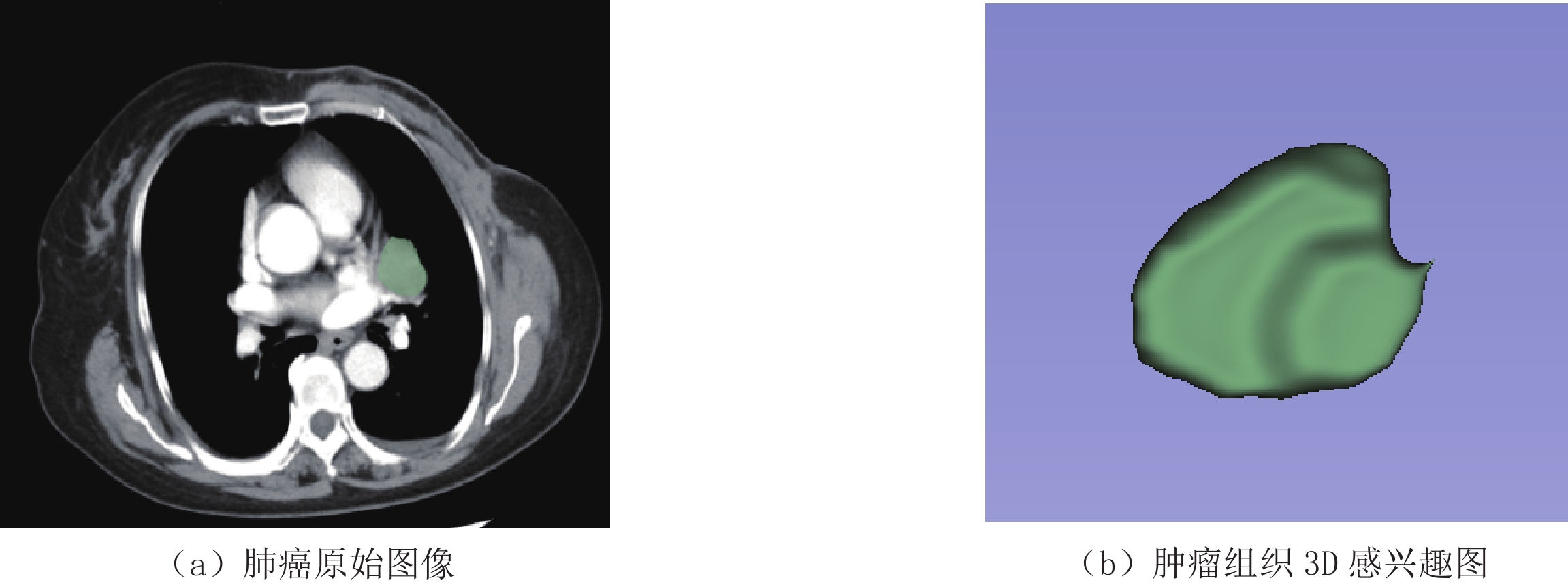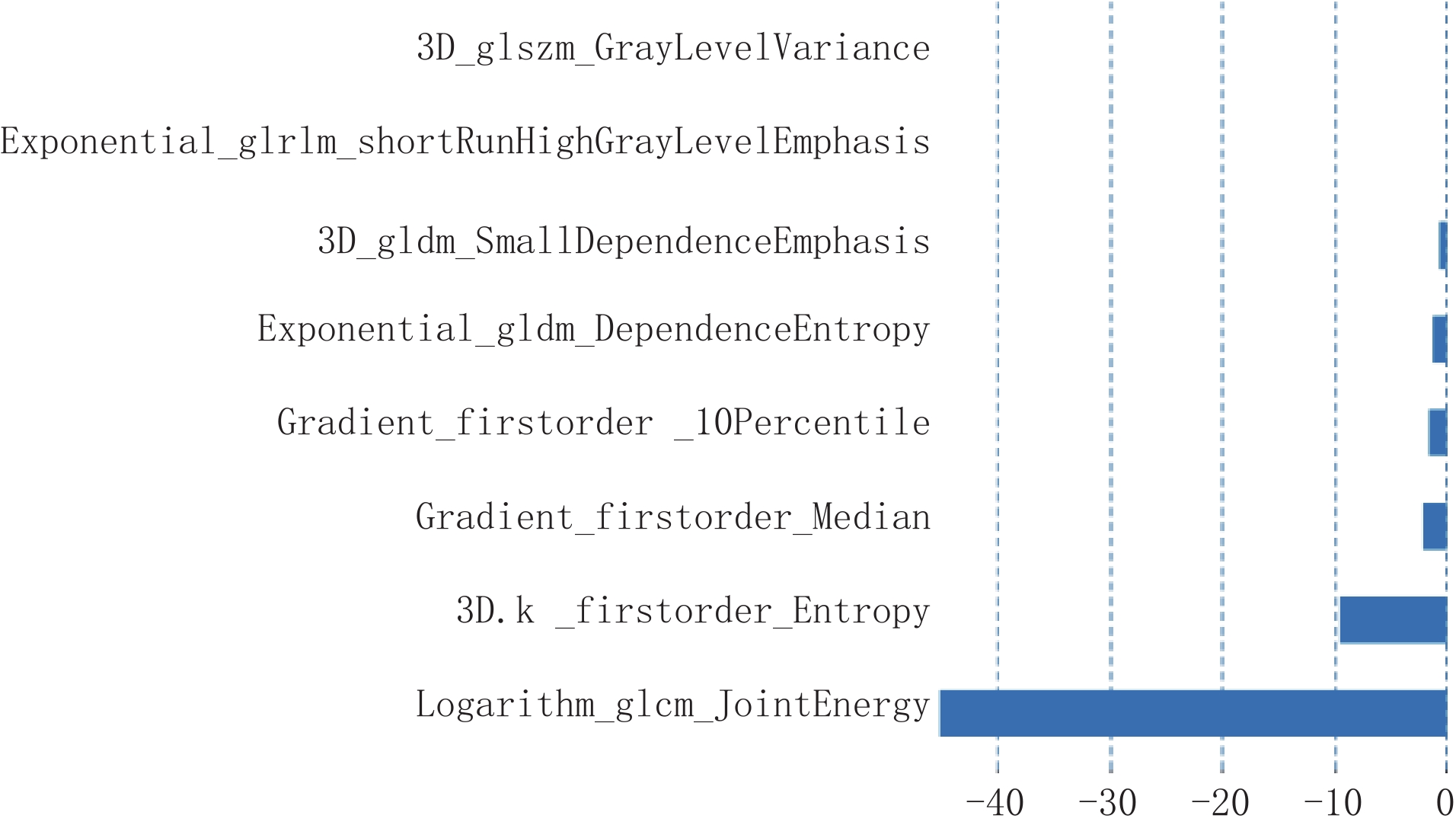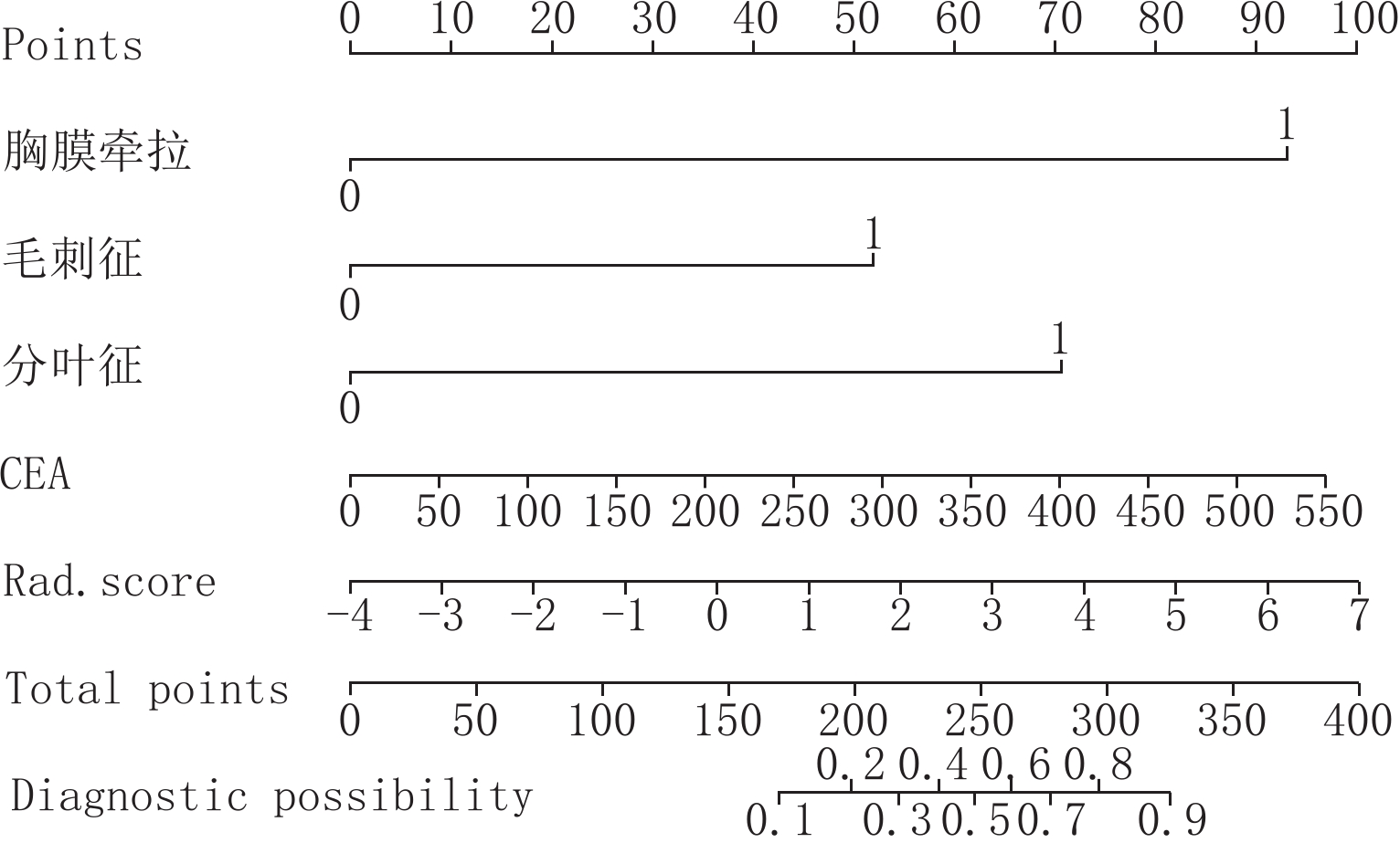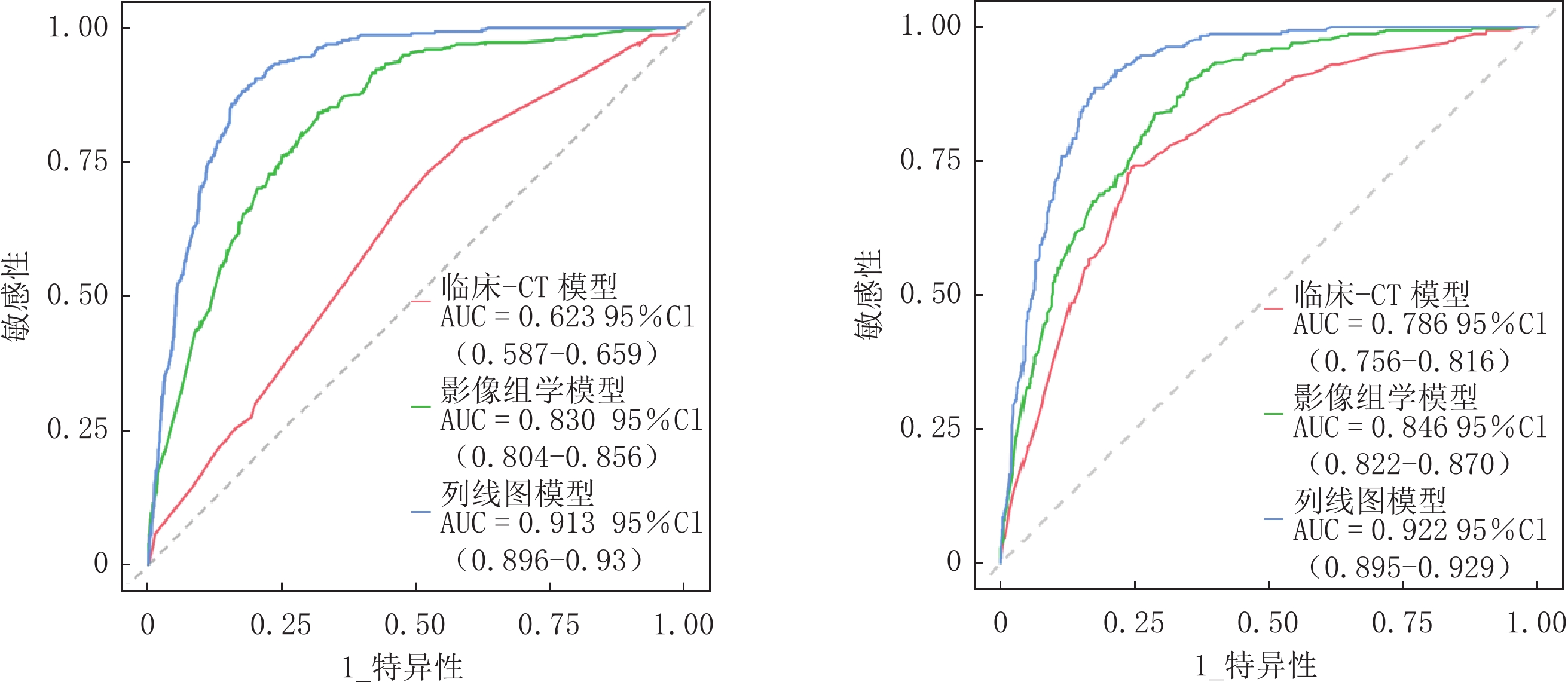The Value of Constructing a Nomogram Model Based on Arterial-phase Imaging Radiomics Features Combined with Clinical-CT Features in Differentiating Lung Squamous Carcinoma and Adenocarcinoma
-
摘要:
目的:探讨基于动脉期影像组学特征联合临床CT特征构建列线图模型在鉴别肺鳞癌(SCC)与肺腺癌(ADC)中的应用价值。方法:回顾性收集2021年8月至2023年9月在我院进行穿刺病理活检或手术的肺癌患者85例作为训练集,同时收集2023年5月至2024年6月经病理证实的肺癌患者40例作为验证集,所有患者均行胸部CT增强检查。根据病理结果将训练集分为SCC组(n=29)和ADC组(n=56)。比较两组患者一般临床资料和CT图像特征的差异,采用单因素和多因素Logistic回归分析筛选出独立预测因素,构建临床-CT模型。应用ITK Snap软件提取训练集动脉期图像影像组学特征,依次采用组内相关系数(ICC)、Roruta特征筛选和最小绝对收缩和选择算子(LASSO)对提取的影像组学特征进行降维处理,筛选出有意义的特征。采用Logistic回归构建动脉期影像组学模型,计算该模型的影像组学评分(Rad-score)。以多因素Logistic回归分析筛选出临床-CT特征有意义的自变量与Rad-score构建联合模型,绘制列线图。应用ROC曲线、校正曲线、H-L检验、Delong检验及临床决策曲线(DCA)对临床-CT模型、影像组学模型及列线图模型进行评价。结果:单因素分析结果显示,分叶征、坏死空洞征均多于ADC组,癌胚抗原(CEA)、血管集束征、胸膜牵拉及毛刺征均少于ADC组。将上述自变量纳入多因素Logistic进一步筛选,结果显示,CEA、分叶征、胸膜牵拉及毛刺征为独立危险因素,基于此构建临床-CT模型的训练集和验证集AUC值分别为0.623和0.786。影像组学特征经降维后共筛选出的有意义特征有8个,分别为一阶特征3个、二阶特征5个。经ROC曲线分析显示,影像组学模型训练集和验证集AUC值分别为0.830和0.846;列线图模型训练集和验证集AUC值分别为0.913和0.922。经Delong检验显示,列线图模型AUC值均明显高于临床-CT模型和影像组学模型;Hosmer-Lemeshow检验结果显示,临床-CT模型、影像组学模型及列线图模型的拟合度均良好;校准曲线分析显示,列线图模型的预测概率曲线与理想曲线最接近,预测精准度更好;DCA分析结果显示,列线图模型的曲线下面积最大,临床净收益最高。结论:基于动脉期影像组学特征联合临床-CT特征构建列线图模型在鉴别SCC与ADC中具有一定的诊断价值,为无创鉴别SCC与ADC提供一种新的诊断方式。
Abstract:Objective: To investigate the value of constructing a nomogram model based on arterial-phase imaging radiomics features combined with clinical-CT features for the differentiation between squamous lung cancer (SCC) and adenocarcinoma of the lung (ADC). Methods: Retrospectively, 85 patients with lung cancer who underwent puncture pathology biopsy or surgery in our hospital, from August 2021 to September 2023, were collected as a training set. Concurrently, 40 patients with pathologically confirmed lung cancer in our hospital, from May 2023 to June 2024, were collected as a validation set. All patients underwent chest CT enhancement. The training set was divided into the SCC group (n=29) and the ADC group (n=56) based on the pathology. General clinical data and CT image characteristics of the two groups of patients were compared and differences were identified. Independent predictors were screened using unifactorial and multifactorial logistic regression analyses, and a clinical-CT model was constructed. ITK Snap software was applied to extract the radiomics features of the arterial-phase images, and the intragroup correlation coefficient (ICC), Roruta feature screening, and least absolute shrinkage and selection operator (LASSO) were sequentially used to downsize the extracted radiomics features, screen out the meaningful features, construct the arterial-phase image radiomics model using Logistic regression, and compute the model's image radiomics score (Rad-score). A multifactor logistic regression analysis was used to screen the independent variables with meaningful clinical-CT characteristics and Rad-score to construct a joint model, and a nomogram graph was plotted. ROC curves, calibration curves, H-L test, Delong test, and clinical decision curves (DCA) were applied to evaluate the clinical-CT, radiomics, and nomogram models. Results: The results of univariate analysis showed that there were more lobular signs and necrotic cavity signs, and fewer carcinoembryonic antigen (CEA), vascular cluster signs, pleural pulling, and burr signs in the SCC than in the ADC group. The above independent variables were included in the multifactorial Logistic analysis for further screening, and the results showed that CEA, lobular sign, pleural pull, and burr sign were independent risk factors. The area under the curve (AUC) values for the training and validation sets of the clinical-CT model constructed based on this were 0.623 and 0.786, respectively. A total of eight meaningful features were screened after dimensionality reduction of the radiomics features, which were three first-order features and five second-order features. The ROC curve analysis showed that the AUC values for the training and validation sets of the radiomics model were 0.830 and 0.846, respectively; and the AUC values for the training and validation sets of the nomogram model were 0.913 and 0.922, respectively. The Delong test showed that the AUC values of the nomogram model were all significantly higher than those of the clinical-CT model and the radiomics model; the Hosmer-Lemeshow test showed that the clinical-CT model, the radiomics model, and the nomogram model were all well fitted; calibration curve analysis showed that the predictive probability curve of the nomogram model was closest to the ideal curve, with better predictive accuracy; and DCA analysis showed that the AUC of the nomogram model was the largest, with the highest net clinical benefit. Conclusion: Constructing a nomogram model based on arterial-phase imaging radiomics features combined with clinical-CT features has some diagnostic value in differentiating SCC from ADC, providing a new diagnostic modality for noninvasive differentiation.
-
Keywords:
- arterial phase /
- radiomics /
- clinical CT features /
- squamous cell carcinoma /
- adenocarcinoma /
- nomogram model
-
胰腺神经内分泌肿瘤(pancreatic neuroendocrine tumor,pNET)是一种十分罕见的肿瘤,起病隐匿,生物学行为表现为高度异质性,既可惰性生长,也可侵袭性生长,甚至发生早期转移,且生物学特性随着疾病的进展而发生变化[1]。近年来,随着检查技术的进步和健康体检的普及,pNET的临床检出率亦呈上升趋势[2]。由于pNET不同的生物学行为,治疗方式及预后也明显不同,因此术前判断肿瘤的侵袭性对临床有重要的指导意义。
以往文献大多数是探讨pNET的CT征象与肿瘤病理分级的相关研究[3-5],很少研究 CT征象对其侵袭性的预测价值,本研究通过分析120例pNET患者的临床及增强CT资料,并结合病理,探讨CT征象对pNET的侵袭性生物学行为的预测价值。
1. 资料与方法
1.1 临床资料
回顾性分析2018年6月至2021年6月上海交通大学医学院附属瑞金医院经手术和病理确诊的pNET患者。纳入标准:①经手术切除病理证实为 pNET,病理资料完整;②手术前 30天内行胰腺CT平扫及增强检查。排除标准:①碘造影剂过敏者;②CT图像肿瘤病灶显示不清;③患者曾有恶性肿瘤史或胰腺手术史。
120例患者中,103例患者为单发病灶、17例多发灶;男58例,女62例,年龄6~80岁。临床上65例患者有不同症状,包括腹痛33例,低血糖症状(如意识障碍、头昏、行为异常以及心慌、心悸和出汗等)22例,其他不典型症状(如恶心、呕吐、纳差以及乏力、腹痛腹胀等)10例。无症状患者55例,在体检或其他原因检查时偶然发现。肿瘤标记物中,神经元特异性烯醇化酶(neuron specific enolase,NSE)异常升高66例,甲胎蛋白(alpha fetoprotein,AFP)异常升高2例,癌胚抗原(carcinoembryonic antigen,CEA)异常升高5例,CA-199异常升高11例,CA125异常升高7例。
1.2 CT检查
120例患者均行胰腺CT平扫及增强扫描,其中,71例采用GE Light Speed VCT 64排螺旋CT,31例采用GE Discovery CT750 HD、18例采用Siemens IQON-SPECTRAL的MDCT设备检查。
由3名具有5年以上工作经验的放射科技师行CT扫描。参数:层厚、间隔5 mm,重建图像层厚l mm,螺距l,管电压120 kV,管电流为自动毫安秒;使用高压注射器经肘部静脉团注非离子型碘造影剂(碘佛醇)1.5 mL/kg,流速为2~3 mL/s,采集2期动态增强CT影像,即增强扫描动脉期(30~35 s)、门静脉期(70~80 s)影像。
1.3 图像评估
CT图像由两名放射科高年资主治医师(参与放射诊断工作≥10年)通过医学影像信息系统(picture archiving and communication systems,PACS)独立进行分析,意见不一致时,由上一级主任医师仲裁得出最终结果。
CT征象的评估:包括病灶部位(胰腺头颈、体、尾部,当肿瘤同时占两个部位时以病灶占据较大位置统计病灶位置)、形态(类圆形或椭圆形、分叶状或不规则形)、包膜(完整、无或不完整)、有无胰管扩张、有无囊变和钙化、肿瘤的强化方式(均匀、不均匀)。
肿瘤大小及CT值的评估:手动测量3次,结果取平均值。包括:①测量肿瘤最大径、最短径;②密度:分别测量平扫、动脉期及门脉期肿瘤实性部分的密度,并计算动脉期差值(动脉期密度与平扫的差值)、门脉期差值(门脉期密度与平扫的差值)。
1.4 统计学分析
采用SPSS 24.0软件进行统计学分析。定性数据以计数表示,使用χ2检验或Fisher确切概率法分析。定量数据使用Kolmogorov-Smirnov测试是否符合正态分布,正态分布资料以
$\bar x\pm s $ 表示,并用独立样本t检验分析。非正态分布的数据用中位数表示四分位范围,使用 Mann-Whitney分析。采用受试者操作特征(receiver operating characteristic,ROC)曲线评价肿瘤最大径、最短径和CT强化指标对pNET侵袭性行为的诊断效能,并计算ROC曲线下面积(area under curve,AUC)、阈值、95% 可信区间(confidence interval,CI)。以差异有统计学意义的CT参数作为协变量进行多变量Logistic回归分析。P<0.05为差异有统计学意义。
2. 结果
2.1 临床及病理资料
依据病理结果(是否侵犯胰腺周围脂肪组织、神经、血管、脾脏、胆总管及胰周淋巴结转移、远处脏器转移等),分为侵袭组(n=64)和无侵袭组(n=56)。侵袭组64例中,侵犯胰周脂肪组织17例,侵犯周围神经5例、脉管癌栓3例,胰周淋巴结转移1例,同时侵犯2个及以上部位38例。
侵袭组与无侵袭组患者在年龄、性别、临床症状、基础疾病方面差异无统计学意义;但肿瘤的分泌功能及病理组织学分级差异有统计学意义。120例pNET中,包括无功能性51例和功能性69例,其中功能性pNET包括胰岛素瘤37例,胃泌素瘤18例,胰高血糖素瘤9例以及生长抑素瘤5例(表1)。
表 1 侵袭组与无侵袭组pNET的临床特征比较Table 1. Comparison of clinical characteristics of pNET between the invasive group and the non-invasive group组别 例数 年龄/岁 性别/例 临床症状
/例基础疾病/例 血清神经元特
异性烯醇化酶
/(ng/mL)分泌功能
/例病理分级
/例男 女 有 无 无 1种 ≥2种 是 否 G1 G2 G3 侵袭组 64 53.72±12.89 33 31 31 33 43 17 4 18.93±6.82 31 33 20 34 10 无侵袭组 56 51.95±14.97 25 31 34 22 44 8 4 30.53±51.13 38 18 38 18 0 统计量 0.485a 0.573b 1.813b 2.730b -1.123 4.609b 20.065b P 0.487 0.470 0.202 0.255 0.261 0.042 <0.001 注:a:t值;b:χ2值。 2.2 CT表现
120例病例均行CT增强扫描,侵袭组和无侵袭组肿瘤在形态、有无包膜、最大径、最短径、肿瘤实性成分动脉期及门脉期强化差值方面有差异,在肿瘤部位、胰管扩张、囊变、钙化、强化方式方面无差异(表2和表3,图1和图2)。
表 2 侵袭组与无侵袭组pNET的CT影像学特征比较结果(例)Table 2. Comparison of CT imaging features of pNET between the invasive group and the non-invasive group (cases)组别 例数 位置 形态 包膜 胰管扩张 囊变 钙化 强化方式 头颈部 体部 尾部 规则 不规则 完整 不完整
或无有 无 有 无 有 无 均匀 不均匀 侵袭组 64 27 12 25 27 37 22 42 21 43 22 42 15 49 24 40 无侵袭组 56 25 15 16 47 9 49 7 13 43 15 41 8 48 25 31 统计值 1.861 22.013 34.889 1.355 0.807 1.615 0.933 P 0.394 <0.001 <0.001 0.311 0.430 0.249 0.354 表 3 侵袭组与无侵袭组pNET的CT影像学特征比较结果Table 3. Comparison of CT imaging features of pNET between the invasive group and the non-invasive group组别 例数 最大径/cm 最短径/cm 肿瘤实性成分强化差值/HU 动脉期差值 门脉期差值 侵袭组 64 4.051±2.920 3.062±2.051 80.933±48.281 73.801±28.912 无侵袭组 56 2.511±1.542 2.084±1.220 112.912±61.953 89.882±39.901 统计检验 统计值 12.518 9.905 10.071 6.501 P 0.001 0.002 0.002 0.012 ![]() 图 1 女,75岁,非侵袭性胰腺神经内分泌肿瘤(a)为CT平扫,示胰头部见一类椭圆形稍低密度灶,密度均匀,边界清。(b)为增强扫描动脉期,示病灶重度强化,强化程度明显高于周围胰腺组织,病灶与胰腺交界面见肿瘤包膜。(c)为增强扫描门脉期,示病灶强化程度不均匀减低,实性部分密度仍高于胰腺组织,分界清,病灶为实性,无囊变坏死。(d)为病理图片,示肿瘤组织呈膨胀性生长,与胰腺组织分界清晰,肿瘤细胞呈器官样排列,细胞形态、大小较一致(HE染色×100)。Figure 1. Female, 75 years old with a non-invasive pancreatic neuroendocrine tumor
图 1 女,75岁,非侵袭性胰腺神经内分泌肿瘤(a)为CT平扫,示胰头部见一类椭圆形稍低密度灶,密度均匀,边界清。(b)为增强扫描动脉期,示病灶重度强化,强化程度明显高于周围胰腺组织,病灶与胰腺交界面见肿瘤包膜。(c)为增强扫描门脉期,示病灶强化程度不均匀减低,实性部分密度仍高于胰腺组织,分界清,病灶为实性,无囊变坏死。(d)为病理图片,示肿瘤组织呈膨胀性生长,与胰腺组织分界清晰,肿瘤细胞呈器官样排列,细胞形态、大小较一致(HE染色×100)。Figure 1. Female, 75 years old with a non-invasive pancreatic neuroendocrine tumor![]() 图 2 女,55岁,侵袭性胰腺神经内分泌肿瘤(a)为CT平扫,示胰尾部见一巨大不规则等密度肿块,密度不均匀,内可见条片低密度影,边界不清。(b)为增强扫描动脉期,示病灶中度不均匀强化,病灶与胰腺交界面未见肿瘤包膜,与周围血管、结肠壁、胃壁分界不清。(c)为增强扫描门静脉期,示病灶实性持续渐进性强化,内见囊变坏死不强化影,病灶以实性成分为主。(d)为病理图片,示肿瘤组织呈浸润性生长,侵犯胰腺周围纤维脂肪组织;肿瘤细胞呈片状排列,细胞大小不一致,部分细胞异型明显,核仁可见(HE染色×100)。Figure 2. Female, 55 years old with a invasive pancreatic neuroendocrine tumor
图 2 女,55岁,侵袭性胰腺神经内分泌肿瘤(a)为CT平扫,示胰尾部见一巨大不规则等密度肿块,密度不均匀,内可见条片低密度影,边界不清。(b)为增强扫描动脉期,示病灶中度不均匀强化,病灶与胰腺交界面未见肿瘤包膜,与周围血管、结肠壁、胃壁分界不清。(c)为增强扫描门静脉期,示病灶实性持续渐进性强化,内见囊变坏死不强化影,病灶以实性成分为主。(d)为病理图片,示肿瘤组织呈浸润性生长,侵犯胰腺周围纤维脂肪组织;肿瘤细胞呈片状排列,细胞大小不一致,部分细胞异型明显,核仁可见(HE染色×100)。Figure 2. Female, 55 years old with a invasive pancreatic neuroendocrine tumor肿瘤的最大径及最短径预测pNET侵袭性行为的ROC曲线的AUC分别为0.693(95%CI 0.598~0.818)、0.690(95%CI 0.594~0.785)(图3);肿瘤实性成分动脉期差值、门脉期差值预测pNET侵袭性行为的ROC曲线的AUC分别为0.730(95%CI 0.642~0.732)、0.640(95%CI 0.530~0.733);结果均显示对pNET的侵袭性行为具有判别效能(图4)。
2.3 利用增强CT定量参数预测pNET的侵袭性行为
筛选出的6个影像学参数(形态、包膜、最大径、最短径、动脉期强化差值、门脉期强化差值)作为变量,以pNET的侵袭性行为为因变量进行多变量Logistic回归分析。Logistic回归方程式为:
$$ y=0.769-0.002\;x ,$$ 其中x为筛选出形态、包膜、最大径、最短径、动脉期强化差值、门脉期强化差值6个影像学参数。
结果显示动脉期强化差值与pNET的侵袭性独立相关(OR=0.25),动脉期强化差值为判断pNET侵袭性行为的独立预测因素(图5),动脉期强化差值最佳临界点为90.1 HU(灵敏度0.714,特异性0.656,阳性预测值64.5%,阴性预测值72.4%,准确率68.3%),动脉期强化差值越小表示肿瘤侵袭性行为风险越高。
3. 讨论
本研究回顾性分析120例pNET患者的临床及增强CT资料,结合手术病理,探讨CT征象对pNET的侵袭性行为的预测价值。结果表明在肿瘤形态、完整包膜、最大径、最短径、动脉期强化差值、门脉期强化差值这6个影像特征方面有差异。通过多变量Logistic回归分析,结果显示动脉期强化差值为判断pNET侵袭性行为的独立预测因素,动脉期强化差值最佳临界点为90.1 HU。
胰腺神经内分泌肿瘤是一种罕见的肿瘤,约占所有胰腺肿瘤的1%~2%[2]。根据细胞的增殖活性包括有丝分裂计数和ki-67指数两项指标,将pNET分为G1、G2和G3三级[3]。肿瘤异质性与肿瘤分级及预后有关[4]。
本研究中,侵袭组G1、G2及G3分别为20例、34例、10例;无侵袭组G1、G2及G3分别为38例、18例、0例;侵袭组与无侵袭组在肿瘤分级方面差异具有统计学意义,提示高级别肿瘤G2/3级更易发生侵袭性行为。有学者研究发现,患者的性别、年龄差异对预测肿瘤分级无统计学意义[4-5],与本研究相符。本研究中侵袭组与无侵袭组患者在临床症状及基础疾病方面差异无统计学意义。本研究结果显示两组在肿瘤部位、胰管扩张、囊变、钙化、强化方式方面差异无统计学意义,Belousova等[6]发现,pNET侵袭组与无侵袭组在肿瘤的部位、囊变、钙化及胰管扩张方面差异无统计学意义,与本研究结果相一致。
根据是否分泌过多激素而产生不同的临床症状,pNET被分为功能性和非功能性。有文献表明无功能性pNET被发现时,约50%~90%为恶性[6-7]。本研究结果显示无功能性pNET(64.7%,33/51)较功能性pNET(44.9%,31/69)更易表现为侵袭性生物学行为,差异有统计学意义,提示无功能性pNET更易表现为侵袭性生物学行为,推测其原因在于无功能pNET通常无临床症状,除非肿瘤增大到压迫或侵犯临近器官并出现症状才发现。
本研究结果显示侵袭组和无侵袭组pNET在大小、形态、包膜方面差异均有统计学意义,肿瘤越大、形态不规则、包膜不完整或无包膜的pNET更具有侵袭性。pNET肿瘤大小、包膜不完整与肿瘤高级别(G2、G3级)、不良预后及转移风险显著相关[6, 8-11];Canellas等[12]研究发现G3级pNET较G1/2级肿瘤更大,肿瘤大于2.0 cm更易发生侵袭性行为。级别越高的肿瘤常浸润生长,容易突破包膜,形成包膜不完整,提示了肿瘤的侵袭性行为。
我们研究发现,肿瘤实性成分在动脉期强化差值、门脉期强化差值方面差异均有统计学意义,非侵袭组肿瘤的实性成分在动脉期、门脉期强化程度及差值明显高于侵袭组,提示非侵袭组肿瘤实性成分血供明显强于侵袭组,推测其原因在于正常胰腺内分泌腺有致密的血管网,分化良好的pNET更可能来自正常的内分泌组织,因此具有密集的血管网络[13-15]。ROC曲线分析结果显示的pNET肿瘤实性部分动脉期及静脉期强化差值曲线下面积分别为0.73和0.64,能较好地预测其侵袭性行为,动脉期强化差值最佳临界点为90.1 HU,动脉期强化差值越小表示肿瘤侵袭性行为风险越高。pNET为血供丰富的肿瘤,其较高的微血管密度(microvascular density,MVD)与高分化pNET显著相关,可预测患者的预后[13]。
我们进一步通过对筛选出的6个差异有统计学意义的影像学参数(形态、包膜、最大径、最短径、动脉期、门脉期强化差值)进行多变量Logistic回归分析,结果显示动脉期强化差值为判断pNET侵袭性的独立预测因素(P=0.001,OR=0.25)。有研究表明,CT增强值对鉴别胰腺神经内分泌肿瘤的病理分级具有价值,病理分级越高的pNET血供越差,影像所见增强后肿瘤的强化程度越低,其中CT动脉早期强化差值越小[5]。Worhunsky等[16]发现动脉期低强化的pNET与肿瘤低分化及不良预后独立相关。这些研究[5,16]都证实了动脉期强化差值在判断pNET分级及预后方面有重要意义,进一步印证了我们的研究结果。
本研究还存在不足:①本研究为回顾性分析,采用的不同 CT机器设备及扫描参数,可能对结果产生一定的影响;②CT在观察肿瘤的包膜、囊变等方面不如MRI的组织分辨率高,在以后的研究中需要结合MRI进行观察;③pNET的G3级病例数相对较少,需要继续收集,以期进一步研究。
综上所述,侵袭性与无侵袭性组pNET在肿瘤形态、完整包膜、最大径、最短径、动脉期强化差值、门脉期强化差值方面存在差异,即肿瘤体积大、形态不规则、包膜不完整或无包膜,肿瘤实性成分动脉期及门脉期强化差值低等征象提示肿瘤具有侵袭性行为,其中动脉期强化差值为判断pNET侵袭性行为的独立预测因素。总之,pNET的一些增强CT特征与侵袭性行为密切相关,这些影像特征对判断肿瘤的侵袭性行为发挥重要作用,在临床工作中具有较强的实用价值。
-
表 1 训练集两组患者临床资料与CT影像特征结果比较(
$\bar x\pm s $ )Table 1 Comparison of clinical data and results of CT imaging characteristics between the two groups of patients in the training set
指标 组别 统计检验 SCC组(n=29) ADC组(n=56) t/${\chi}^2 $/Z P 年龄 72.21±9.27 67.84±9.64 1.206 0.144 性别 男 24(82.76) 28(50.00) 1.231 0.121 女 5(17.24) 28(50.00) 吸烟史 是 19(65.52) 34(60.71) 0.188 0.665 否 10(34.48) 22(39.29) 家族肿瘤史 是 12(41.38) 26(46.43) 0.197 0.657 否 17(58.62) 30(53.57) NSE(ng/mL) 4.56(3.04, 7.38) 6.24 (4.12, 8.33) 0.413 0.115 CEA(ng/mL) 96.53±8.15 198.22±21.51 6.495 <0.001 CA242(IU/mL) 28.42±4.37 37.49±5.84 1.037 0.189 CA199(U/mL) 51.17±9.53 65.27±10.51 0.202 0.565 坏死空洞 有 25(86.21) 13(23.21) 35.325 <0.001 无 2(6.89) 43(76.79) 毛刺征 有 10(34.48) 45(80.36) 17.606 <0.001 无 19(65.52) 11(19.64) 分叶征 有 26(89.66) 10(17.86) 40.340 <0.001 无 3(10.34) 46(82.14) 空泡征 有 22(75.86) 32(57.14) 2.890 0.089 无 7(24.14) 24(42.86) 胸膜牵拉 有 16(55.17) 44(78.57) 4.574 0.032 无 13(44.83) 12(21.43) 血管集束征 有 13(44.83) 41(73.21) 6.645 0.010 无 16(55.17) 15(26.79) 肿瘤位置 上叶 18(62.07) 30(53.57) 2.011 0.093 中叶 3(10.34) 9(16.07) 下叶 8(27.59) 17(30.36) 表 2 ADC及SCC多因素Logistic回归分析结果
Table 2 Results of Multifactor Logistic Regression Analysis of ADC and SCC
变量 β SE Wald $\chi^2 $ OR 95% CI Z P CEA 0.005 0.003 1.880 1.005 (1.000~1.010) 1.987 0.047 分叶征 1.992 0.719 4.712 7.328 (1.931~33.680) 2.768 0.006 胸膜牵拉 1.413 0.599 2.883 4.109 (1.340~14.58) 2.359 0.018 毛刺征 1.466 0.736 2.346 4.333 (1.103~20.300) 1.993 0.046 常数 −5.977 1.355 0.587 0.003 (0.000~0.025) −4.410 <0.001 表 3 临床-CT模型、影像组学模型及列线图模型诊断效能比较(%)
Table 3 Comparison of diagnostic efficacy of clinical-CT model, radiomics model, and nomogram model(%)
数据集 模型 AUC (95% CI) 敏感性 特异性 阳性预测值 阴性预测值 训练集 临床-CT模型 0.623(0.587~0.659) 76.79 71.82 76.58 75.45 影像组学模型 0.830(0.804~0.856) 83.78 80.63 81.55 79.92 列线图模型 0.913(0.896~0.930) 92.59 88.74 90.77 86.01 验证集 临床-CT模型 0.786(0.756~0.816) 73.83 75.58 73.53 88.34 影像组学模型 0.846(0.822~0.870) 83.89 81.10 82.52 92.05 列线图模型 0.922(0.895~0.929) 93.01 82.48 89.84 90.99 -
[1] 傅睿, 吴一龙, 钟文昭. 2020版肺癌多学科团队诊疗中国专家共识解读[J]. 中国肿瘤临床, 2022, 49(4): 163−167. DOI: 10.12354/j.issn.1000-8179.2022.20211201. FU R, WU Y L, ZHONG W Z. Interpretation of Chinese expert consensus on multidisciplinary team diagnosis and treatment of lung cancer (2020 version)[J]. Chinese Tumor clinical, 2022, 49(4): 163−167. DOI: 10.12354/j.issn.1000-8179.2022.20211201. (in Chinese).
[2] 王馨慧, 张笑雪, 聂奔, 等. 联合免疫模式在晚期非小细胞肺癌治疗中的研究进展[J]. 临床肿瘤学杂志, 2023, 28(3): 263−269. DOI: 10.3969/j.issn.1009-0460.2023.03.011. WANG X H, ZHANG X X, NIE B, et al. Research progress of combined immunotherapy mode in the treatment of advanced non-small cell lung cancer[J]. Chinese Clinical Oncology, 2023, 28(3): 263−269. DOI: 10.3969/j.issn.1009-0460.2023.03.011. (in Chinese).
[3] 吕祥瑞, 皇甫娟, 王孟丽, 等. 血清肿瘤标志物与肺癌病理类型的相关性研究[J]. 癌症进展, 2021, 19(14): 1451−1455. DOI: 10.11877/j.issn.1672-1535.2021.19.14.13. LV X R, HUANG P J, WANG M L, et al. Study on the correlation between serum tumor markers and pathological types of lung cancer[J]. Oncology Progress, 2021, 19(14): 1451−1455. DOI: 10.11877/j.issn.1672-1535.2021.19.14.13. (in Chinese).
[4] 张盼, 黄庆, 汪扬, 等. 非小细胞肺癌动态增强CT扫描下临床表现特征与其病理类型的关系[J]. 西部医学, 2023, 35(4): 584-587. DOI: 10.3969/j.issn.1672-3511.2023.04.023. ZHANG P, HUANG Q, WANG Y, et al. Clinical characteristics of dynamic contrast-enhanced CT scan and their relationship with pathological types in non-small cell lung cancer[J]. Western Medicine, 2023, 35(4): 584-587. DOI:10.3969/j.issn.1672-3511.2023.04.023. (in Chinese).
[5] 陈杰, 洪悦, 王艳, 等. 基于CT平扫影像组学特征在预测胸腺上皮性肿瘤WHO简化病理分型中的价值[J]. 中国CT和MRI杂志, 2024, 22(1): 71−73. DOI: 10.3969/j.issn.1672-5131.2024.01.023. CHEN J, HONG Y, WANG Y, et al. Value of simplified pathological classification of thymus epithelial tumors based on plain CT imaging features[J]. Chinese Journal of CT and MRI, 2024, 22(1): 71−73. DOI: 10.3969/j.issn.1672-5131.2024.01.023. (in Chinese).
[6] 党俊明, 朱超华, 黄慧娴, 等. 基于MRI影像组学特征预测宫颈腺癌与鳞癌病理分型的研究[J]. 医疗卫生装备, 2022, 43(5): 54−59. DOI: 10.19745/j.1003-8868.2022099. DANG J M, ZHU C H, HUANG X H, et al. Prediction of pathological classification of cervical adenocarcinoma and squamous cell carcinoma based on MRI radiomics characteristics[J]. Medical and Health Equipment, 2022, 43(5): 54−59. DOI: 10.19745/j.1003-8868.2022099. (in Chinese).
[7] 高琳, 于鑫鑫, 康冰, 等. CT 影像组学对肺纯磨玻璃结节浸润性的预测价值[J]. 山东大学学报(医学版), 2022, 60(5): 87−97. DOI: 10.6040/j.issn.1671-7554.0.2022.0500. GAO L, YU X X, KANG B, et al. Predictive value of CT-based radiomics nomogram for the invasiveness of lung pure ground-glass nodules[J]. Journal of Shandong University (Health Sciences), 2022, 60(5): 87−97. DOI: 10.6040/j.issn.1671-7554.0.2022.0500. (in Chinese).
[8] 中华医学会, 中华医学会肿瘤学分会, 中华医学会杂志社. 中华医学会肺癌临床诊疗指南(2019版)[J]. 中华肿瘤杂志, 2020, 42(4): 257−287. DOI: 10.3760/cma.j.cn112152-20200120-00049. Chinese Medical Association, Chinese Medical Association Oncology Branch, Journal of Chinese Medical Association. Chinese Medical Association guidelines for clinical diagnosis and treatment of lung cancer (2019 edition)[J]. Chinese Journal of Tumors, 2020, 42(4): 257−287. DOI: 10.3760/cma.j.cn112152-20200120-00049. (in Chinese).
[9] 朱玲玲, 伍娟, 王艇, 等. 2023年第2版NCCN肺癌筛查临床实践指南更新解读[J]. 实用肿瘤杂志, 2023, 38(5): 399−407. DOI: 10.13267/j.cnki.syzlzz.2023.063. ZHU L L, WU J, WANG T, et al. Updated interpretation of NCCN clinical practice guidelines for lung cancer screening, version 2.2023[J]. Journal of Practical Oncology, 2023, 38(5): 399−407. DOI: 10.13267/j.cnki.syzlzz.2023.063. (in Chinese).
[10] 蒋会东, 谢强, 李军, 等. 64排CT联合NSE、ProGRP在肺癌鉴别诊断及TNM分期中的应用[J]. 中国现代医学杂志, 2022, 32(14): 95−100. DOI: 10.3969/j.issn.1005-8982.2022.14.017. JIANG H D, XIE Q, LI J, et al. Application of 64-detector-row CT combined with NSE and ProGRP in differential diagnosis and TNM staging of lung cancer[J]. China Journal of Modern Medicine, 2022, 32(14): 95−100. DOI: 10.3969/j.issn.1005-8982.2022.14.017. (in Chinese).
[11] 孔令芹, 陈苏媛, 李西川, 等. 早中期小细胞肺癌与非小细胞肺癌CT影像及肿瘤标记物对比[J]. 中国医学创新, 2023, 20(17): 42−46. DOI: 10.3969/j.issn.1674-4985.2023.17.010. KONG L Q, CHEN S Y, LI X C, et al. Comparison of CT images and tumor markers between early and middle stage small cell lung cancer and non-small cell lung cancer[J]. MedicaI Innovation of China, 2023, 20(17): 42−46. DOI: 10.3969/j.issn.1674-4985.2023.17.010. (in Chinese).
[12] 唐新, 梁江涛, 向柏林, 等. PET/MRI影像组学特征预测肺腺癌与肺鳞癌病理分型价值[J]. 浙江医学, 2022, 44(6): 580−584. DOI: 10.12056/j.issn.1006-2785.2022.44.6.2021-2731. TANG X, LIANG J T, XIANG B L, et al. Application of PET/MRI radiomics in differentiating the pathological types of lung adenocarcinoma and squamous cell carcinoma[J]. Zhejiang Medicine, 2022, 44(6): 580−584. DOI: 10.12056/j.issn.1006-2785.2022.44.6.2021-2731. (in Chinese).
[13] 孙士鹤, 侯艳娟, 刘芬, 等. CT诊断老年肺癌患者病理亚型与病理学诊断的一致性及其影像学特征[J]. 中国老年学杂志, 2023, 43(24): 5915−5918. DOI: 10.3969/j.issn.1005-9202.2023.24.007. SUN S H, HOU Y J, LIU F, et al. Concordance between pathologic subtypes and pathologic diagnoses and their imaging features in CT-diagnosed elderly patients with lung cancer[J]. Chinese Journal of Gerontology, 2023, 43(24): 5915−5918. DOI: 10.3969/j.issn.1005-9202.2023.24.007. (in Chinese).
[14] 王守玉, 屈开新, 王庆龙, 等. 不典型肺癌CT诊断与鉴别诊断[J]. 中国医药科学, 2020, 10(15): 187−190. DOI: 10.3969/j.issn.2095-0616.2020.15.051. WANG S Y, QU K X, WANG Q L, et al. CT diagnosis and differential diagnosis of atypical lung cancer[J]. China Medicine and Pharmacy, 2020, 10(15): 187−190. DOI: 10.3969/j.issn.2095-0616.2020.15.051. (in Chinese).
[15] 彭弘, 李圣博, 赵旭. 周围型肺癌CT征象与病理的对照相关性研究[J]. 罕少疾病杂志, 2022, 29(12): 42−43. DOI: 10.3969/j.issn.1009-3257.2022.12.019. PENG H, LI S B, ZHAO X. A comparative study of CT signs and pathology of peripheral lung cancer[J]. Journal of Rare and Uncommon Diseases, 2022, 29(12): 42−43. DOI: 10.3969/j.issn.1009-3257.2022.12.019. (in Chinese).
[16] 张英惠. 96例早期周围型肺癌的CT影像特征分析[J]. 中国现代药物应用, 2022, 16(4): 87-90. DOI: 10.14164/j.cnki.cn11-5581/r.2022.04.033. ZHANG Y H. Analysis of CT imaging features of 96 cases of early-stage peripheral lung cancer[J]. Chinese Modern Drug Application, 2022, 16(4): 87-90. DOI:10.14164/j.cnki.cn11-5581/r.2022.04.033.(in Chinese).
[17] 谭淦纹, 曹欢, 王玲. 肺癌MSCT增强扫描影像学征象与CA199、CA242、NSE表达的相关性及临床应用价值研究[J]. 中国CT和MRI杂志, 2022, 20(3): 49−51. DOI: 10.3969/j.issn.1672-5131.2022.03.016. TAN J W, CAO H, WANG L. Correlation between imaging signs of MSCT enhanced scanning of lung cancer and the expression of CA199, CA242, NSE, and its clinical application value[J]. Chinese Journal of CT and MRI, 2022, 20(3): 49−51. DOI: 10.3969/j.issn.1672-5131.2022.03.016. (in Chinese).
[18] 陈宝华, 段强军. 血清 CEA、NSE 联合影像学特征在肺癌分期及预后中的价值[J]. 分子诊断与治疗杂志, 2022, 14(9): 1615−1619. DOI: 10.3969/j.issn.1674-6929.2022.09.040. CHEN B H, DUANG Q J. The value of serum CEA and NSE combined with imaging features in lung cancer staging and prognosis[J]. Journal of Molecular Diagnosis and Treatment, 2022, 14(9): 1615−1619. DOI: 10.3969/j.issn.1674-6929.2022.09.040. (in Chinese).
[19] 肖蓉, 潘频华. 老年肺癌CT影像学特征与特异性标记物的相关性研究及联合诊断[J]. 国际老年医学杂志, 2020, 41(6): 391−394. DOI: 10.3969/j.issn.1674-7593.2020.06.013. XIAO R, PAN P H. Correlation between CT imaging features and specific markers and their combined diagnostic value in lung cancer in older patients[J]. International Journal of Geriatrics, 2020, 41(6): 391−394. DOI: 10.3969/j.issn.1674-7593.2020.06.013. (in Chinese).
[20] ZHU X, DONG D, CHEN Z, et al. Radiomic signature as a diagnostic factor for histologic subtype classification of non-small cell lung cancer[J]. Eur Radiol, 28(7): 2772-2778. DOI: 10.1007/s00330-017-5221-1.
[21] 唐聪聪, 陈艾琪, 曹胜男, 等. CT 影像组学在非小细胞肺癌病理分级中的应用[J]. 蚌埠医学院学报, 2023, 48(6): 783-786. DOI: 10.13898/j.cnki.issn.1000-2200.2023.06.017. TANG C C, CHEN A Q, CAO S N, et al. Application of CT radiomics in the pathological grading of non-small cell lung cancer[J]. Journal of Bengbu Medical College, [21]2023, 48(6): 783-786. DOI:10.13898/j.cnki.issn.1000-2200.2023.06.017. (in Chinese).
[22] 方家杨, 梁长宇, 陶俊利, 等. 基于临床、影像组学和计算机视觉特征鉴别肺鳞癌和腺癌[J]. 中国医学影像学杂志, 2022, 30(7): 691−696,702. DOI: 10.3969/j.issn.1005-5185.2022.07.010. FANG J Y, LIANG C Y, TAO J L, et al. Differentiation of lung squamous cell carcinoma and adenocarcinoma based on clinical, radiomic and computer vision features[J]. Chinese Journal of Medical Imaging, 2022, 30(7): 691−696,702. DOI: 10.3969/j.issn.1005-5185.2022.07.010. (in Chinese).
[23] 陆亮, 徐圆. 影像组学联合CT特征对周围型肺腺癌及鳞癌的鉴别价值研究[J]. 医疗卫生装备, 2021, 42(10): 48−52, 63. DOI: 10.19745/j.1003-8868.2021211. LU L, XU Y. Diagnostic value of radiomics combined with CT features for differentia-ting peripheral lung adenocarcinoma from squamous cell carcinoma[J]. Chinese Medical Equipment Journal, 2021, 42(10): 48−52, 63. DOI: 10.19745/j.1003-8868.2021211. (in Chinese).
[24] 汪靖婷, 钟飞扬, 甘甜, 等. 基于临床及 CT 影像组学特征构建周围型小细胞肺癌与肺腺癌诊断模型的研究[J]. 临床放射学杂志, 2023, 42(3): 406-410. DOI: 10.13437/j.cnki.jcr.2023.03.035. WANG T T, ZHONG F Y, GAN T, et al. Study on the differential diagnosis model between periph eral SCLC and ADC based on clinical and CT radiomics features[J]. Journal of Clinical Radiology, 2023, 42(3): 406-410. DOI:10.13437/j.cnki.jcr.2023.03.035. (in Chinese).
[25] WEN C L, MENG P L, WEN Y H, et al. A practical dynamic nomogram model for predicting bone metastasis in patients with thyroid cancer[J]. Front Endocrinol (Lausanne), 2023, 14: 1142796. DOI: 10.3389/fendo.2023.1142796.
[26] FENG H, YU Q S, WANG J X, et al. Establishment and validation of nomogram prediction model for complicated acute appendicitis[J]. Zhonghua Wai Ke Za Zhi, 2023, 61(12): 1074−1079. DOI: 10.3760/cma.j.cn112139-20230104-00005.
-
期刊类型引用(2)
1. 宋冉,梁长华,李强. 能谱CT结合血清miR-23a预测大面积急性心肌梗死患者主要心血管不良事件发生风险的价值. 海南医学. 2025(04): 528-533 .  百度学术
百度学术
2. 夏宾,叶鹏飞,邵祎炜,李俊杰,李宇庆. 心肌灌注成像联合增强CT评估心肌缺血患者再灌注损伤的价值. 河南医学研究. 2024(03): 550-554 .  百度学术
百度学术
其他类型引用(0)




 下载:
下载:
















